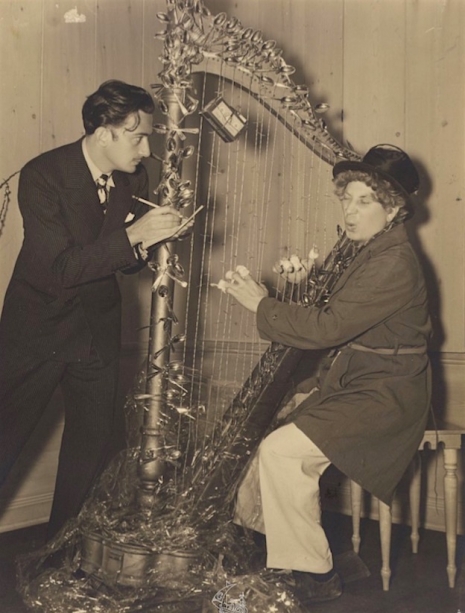
Salvador Dali loved the Marx Brothers. He loved their madcap, anarchic comedy. In particular Dali loved Harpo Marx—the blonde corkscrew-haired comic mime whose visual comedy—unlike the quick witty repartee of his brother Groucho—was universal and needed no translation. Dali described Harpo as one of America’s three great Surrealists—the other two being Walt Disney and Cecil B. DeMille.
The pair first met at a party in Paris in 1936. Harpo told Dali how much he liked his paintings. Dali told Harpo how much he loved his films—in particular Animal Crackers which he described as “the summit of the evolution of comic cinema.” Dali gushed over Harpo’s performance where he pulled fish and cutlery from his pocket and shot the hats of beautiful women—this was true Surrealism!
Understandably, the two men became friends.
Dali later wrote “an entertaining, if rather implausible account” of his meeting with Harpo for Harper’s Bazaar in 1937:
I met Harpo for the first time in his garden. He was naked, crowned with roses, and in the center of a veritable forest of harps (he was surrounded by at least five hundred harps). He was caressing, like a new Leda, a dazzling white swan, and feeding it a statue of the Venus de Milo made of cheese, which he grated against the strings of the nearest harp. An almost springlike breeze drew a curious murmur from the harp forest. In Harpo’s pupils glows the same spectral light to be observed in Picasso’s.
When Harpo returned to America, Dali sent him a harp wrapped in cellophane with barbed wire for strings and spoons, knives and forks glued all over its frame. In return Harpo sent Dali a photograph of himself playing the harp with bandaged fingers. He invited Dali to Hollywood saying he’d be more than happy to pose for the great artist—if he cared to smear paint all over him. Dali was delighted to take up the offer. In 1937, he arrived in Hollywood with his wife Gala. He visited Harpo and sketched him playing his barbed wire harp with a lobster on his head. Natch.
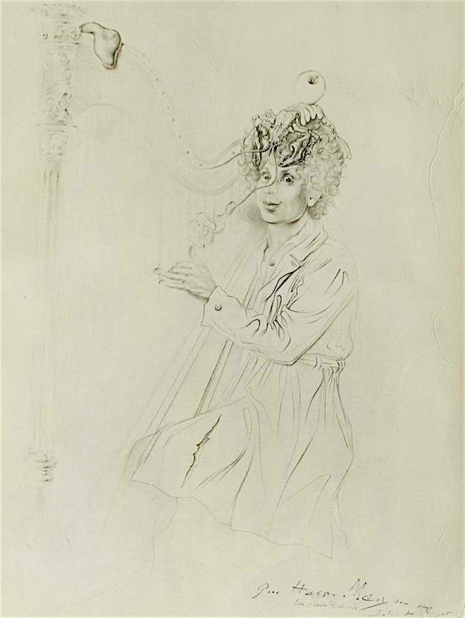
Dali’s sketch of Harpo playing the harp.
Dali brought Harpo a gift—a movie script he wanted the Marx Brothers to make. The script was called Giraffes on Horseback Salads or The Surrealist Woman. It was a series of unconnected scenes typed in blue ribbon over twenty-two pages with various notes written in ink. Dali had already made two infamous films with his friend the director Luis Buñuel—Un Chien Andalou (1929) and L’Age d’Or. Now he wanted to cast Harpo and cinema’s “greatest Surrealist act” the Marx Brothers in a film that just might revolutionize Hollywood—or maybe not...
Giraffes on Horseback Salads
The “Surrealist woman” is lying in the middle of a great bed, sixty feet long, with the rest of the guests seated around each side. Along the bed, as decorations, are a group of dwarfs caught by Harpo. Each is supported on a crystal base, decorated with climbing flowers. The dwarfs stay as still as statues, holding lighted candelabras, and change their positions every few minutes.
While love tears at Jimmy’s heart, Groucho tries to crack a nut on the bald head of the dwarf in front of him. The dwarf, far from looking surprised, smiles at Groucho in the most amiable way possible. Suddenly in the middle of dinner, thunder and lightning begin inside the room. A squall of wind blows the things over on the table and brings in a whirl of dry leaves, which stick to everything. As Groucho opens his umbrella, it begins to rain slowly.
Although the guests show surprise, they try for a time to continue their meal, which is, however, brought to an end by showers of rain. In a panic, the guests rush in all directions, while from the hall a torrent of waters washes in, bringing with it all sorts of debris, including a drowned ox. A shepherd makes a desperate effort to collect his flock of sheep, which climb up on the sofas and the bed in an effort to avoid being carried away by the water. A cradle is carried in on the flood containing a baby crying piteously, followed by the mother, hair streaming behind her.
The “Surrealist woman” crosses several rooms - rain falling more and more heavily - but stops in front of a door and hesitates. She goes in, followed by Jimmy, who has never left her side. On the other side of the door, there is no more rain and everything changes. It is the childhood room of the “Surrealist woman,” where by her orders nothing has been touched since she was ten. Overcome by emotion, she sits down in front of a mirror at a child’s table.
Meanwhile, the Marx Brothers announce that a great fête is going to take place. For this, large preparations have to be made. Four acres of desert are cleared of cacti and of all vegatation and flattened out like a tennis court. The undergrowth that is cleared away is piled around the field to make a barrier, behind which stands are erected for spectators.
There is a competition for the person who can ride a bicycle the slowest with a stone balanced on his head. All the participants have to grow beards. In the middle is a tower in the form of a boat’s prow to be used as a judge’s box.
Before the spectacle begins, the vegetation around the fields is set alight. This prevents the spectators in the stands from seeing anything at all. From the top of the tower the sight is wonderful, with columns of smoke going up vertically, surrounding hundreds of cyclists—each balancing a rock on his head—threading their way with the sun setting behind.
In the tower, Harpo is playing his harp ecstatically, like a modern Nero. By his side, his back to the spectacle, Groucho is lying, smoking lazily. Nearby, the “Surrealist woman” and Jimmy watch the spectacle, lying side by side. Behind them, Chico, dressed in a diving suit, accompanies Harpo on the piano. Scattered across the gangway leading to the tower, an orchestra plays the theme song with Wagnerian intensity as the sun sinks under the horizon.
Harpo was flattered by Dali’s attention. He wanted to work with the great artist and thought Giraffes on Horseback Salads might make the basis for a new Marx Brothers film. He took the script to his brothers. Groucho thought it was a stinker—it just wasn’t funny—and where were the jokes? The studio could make neither heads nor tails of it. The thought of all the special effects was beyond the realms of possibility.
The project was dropped.
Dali was unmoved by the script’s rejection—it seemed just the very idea of having written a script and presenting it as a token of esteem to Harpo Marx was sufficient for him.
Giraffes on Horseback Salads was long thought lost until it was discovered among Dali’s personal papers after his death. The script was eventually published in Harper’s Magazine in May 1996.
Below some of Dali’s sketches for Giraffes on Horseback Salads.
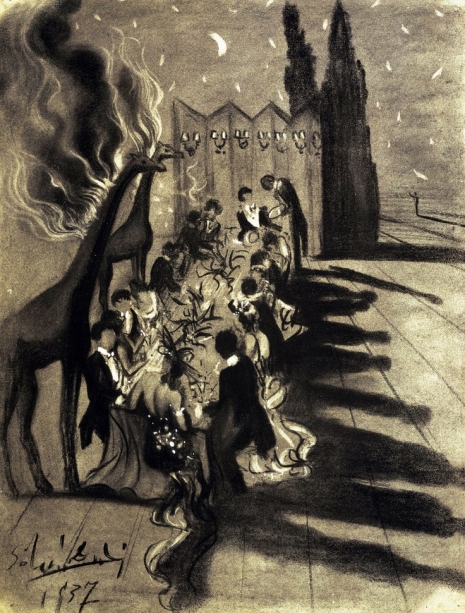
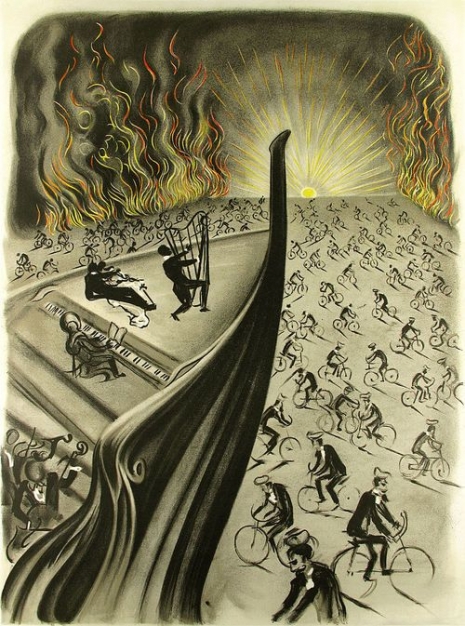
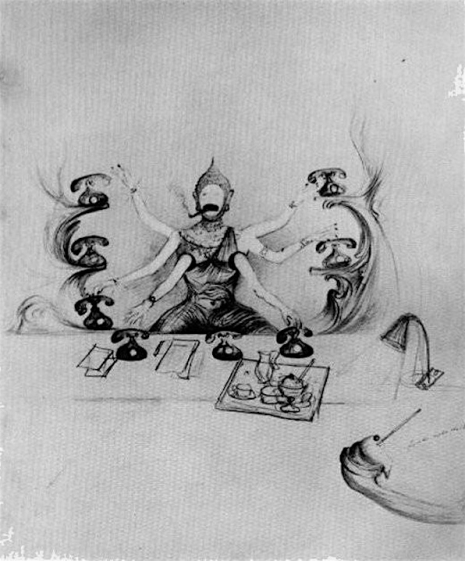
Dali’s sketch of Groucho as Shiva.

H/T Miskatonic.